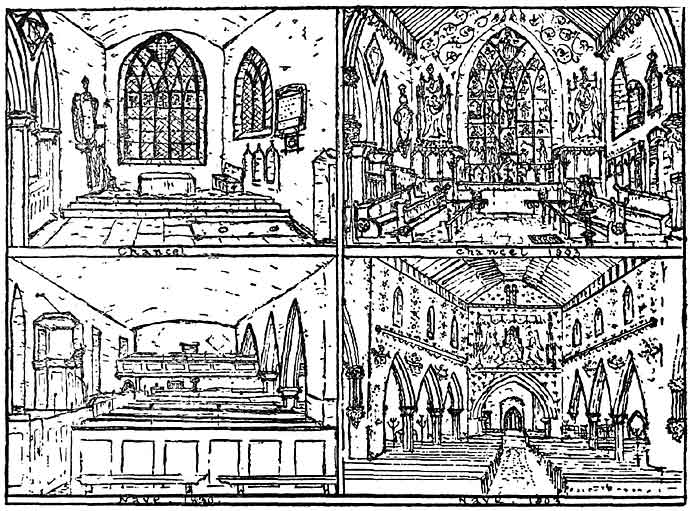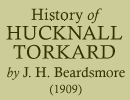< Previous | Contents | Next >
A structural alteration occurred in the 18th century, and was of a debasing character. The shapely tower arch was bricked up, a singing gallery erected at the west end, pews of the horse-box style replaced the open benches, and a three-decker pulpit was erected on the side of the south wall in the nave. A square-headed window was opened out over the porch to admit light to the singers' gallery, two long, ugly-shaped windows replaced the 14th century lights, and whitewash was freely used on walls and ceiling. Thus did the age of ugliness and irreligion max and deface the Parish Church at Hucknall.
The next step in enlargement and restoration was carried through in the years 1871-2, the work being undertaken at the instance of the late Mr. John Godber, who offered £500 towards the improvement. The project was rendered practicable by liberal gifts from the late Duke of Portland, Canon Godber, Rev. Luke Jackson, Mr. and Mrs. Needham Ball, Mr. James Widdowson, and the Byron Charity Trust (£500). A south aisle was added, a tiled roof put over the nave and chancel, and the interior embellished at a cost of £3,200.
The rapid increase of population soon rendered another enlargement necessary, and in 1887, during the vicariate of the Rev. J. E. Phillips, the church was enlarged by the removal eastwards of the chancel, spacious transepts being inserted in the gap between nave and chancel, and a clerestory raised over the nave. This work cost £4,846, and the building, when finished, provided sittings for nearly 800 people.
This picture presents a contrast between the interior of the Church as it was before the 1872 alteration, and after the enlargement in 1888. In the 1830 picture the Byron tomb is shown in the foreground of the Church, the entrance to the steps being covered with a huge flagstone in which two heavy iron rings were inserted. Through a chipping at one corner of this stone the old sexton of 1840 used to lower a tallow candle into the tomb to gratify the morbid curiosity of visitors with a sight of the poet's coffin. A lady came one day and coaxed the old man to let her peep, and she then reported the circumstance to the newspapers., after which the practice was stopped. Among the many anecdotes of visitors to the vault is one to the effect that Kossuth, the great patriot, when at Hucknall, eagerly purchased a small fragment of velvet which a child had torn from the poet's coffin. Having secured this relic, he expressed his intention to wear it near his heart, in loving memory of the greatest poet of liberty. Between the arches dividing the chancel from the side chapel was a hatchment carrying the Byron Arms, placed there when some member of the family was buried in the vault below. The hatchment now hangs on the tower wall. To the left of the Communion Table hangs the Vicar's surplice and the black gown with which he robed himself when about to preach. In the lower left-hand sketch the pulpit is shown attached to the south wall; the large pew beneath it was called the "Byron Pew." Below the pulpit was the clerk's desk, that official taking a more important part in the services in the 18th and early part of the 19tb century than now.

On Sunday afternoons in winter, when the Rev. Charles Nixon (Rector of Nuttall
and Vicar of Hucknall) used to ride over here on horseback to conduct service,
the church was lighted by tallow candles stuck in the sockets which were
elevated above the pews by iron wire standards. An alms-box formed of a log
of oak, 3 feet long, stood near the porch, the cup scooped out of the solid
wood, and covered with a perforated wooden lid, iron bound, and fastened
with two padlocks. In the middle of the great east window fragments of old
stained glass were leaded into the five panels without regard to pattern
except in the central panel, in which a rudely shaped cross was fashioned.
These glass fragments were the remains of heraldic shields of various important
families who held lands in the parish previous to the time of the Commonwealth,
and are illustrated on page
At the western end of the nave and north aisle a gallery was erected about the year 1740 for the accommodation of the choristers and instrument players, who continued to occupy it until the year 1871, the wind and stringed instruments being superseded by a harmonium in 1854.
Up to the year 1874 at least half the pews were allotted to prominent residents, but in that year, in response to popular demand, it was decided that the Beats should thenceforward be free and unappropriated.
In the 1871-2 alterations the gallery was taken down, the brickwork which blocked up the tower arch removed, the rotten old oaken roof demolished and replaced by open timber work covered with tiles, the south aisle added, and the whole church repewed. Floor tiles were used instead of the old limestone pavers. The east window was filled with stained glass, and shortly afterwards the chancel was panelled with oak and a reredos of the same material erected. The piscina (recess in chancel wall used in olden days for holding water for celebration of Mass) was found and opened out, and the sedilia (three stone seats set in the wall, formerly occupied by priest, deacon, and sub-deacon) were also restored. The restorers separated the chancel from the nave by a carved oaken screen, a new pulpit was erected (A), and gas was introduced in place of candles.
To the right of the Communion Table, in the corner beyond the sedilia stood an old Elizabethan chest (see picture). Bishop Trollope visited the church in 1878, and noted that the chest had then been removed to the tower, where it was being used as a receptacle for graveyard utensils. It was allowed to decay, but the lid was found two years ago by Mr. Herbert Brown and given to the Vicar, who has recently had it fitted on a box and placed it in the church. The chest was made to hold the parish registers, but in 1812 an Act was passed to secure the preservation of registers, so a little iron safe was procured for the purpose, and a few years ago a large modern fireproof safe was bought for the secure keeping of registers and church plate.
< Previous | Contents | Next >
(A) This is now in St. John's Church.
